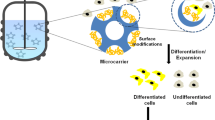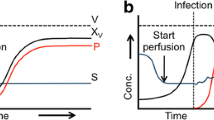Abstract
Only a decade after Van Wezel introduced the first product made in microcarrier cultures on industrial scale at economically acceptable costs, namely Inactivated Polio Vaccine (IPV), interest was taken in this revolutionary type of cell growth system. The basic idea was to develop a culture system with equal potentials for control of environmental culture conditions and scaling up as the systems used in industrial microbiology. Although initially only positively-charged beads were used it soon became clear that negatively-charged or amphoteric materials such as proteins or amino acids polymerized to the surface were equally useful. Eventually numerous different types of microcarrier were developed. The second generation of microcarriers consisted of macroporous beads providing increased surface area for cell attachment and growth by external and interior space. Such microcarriers offer great potential for high cell densities and enhanced productivity for certain production systems, especially recombinant CHO-cells. These carriers, which not only provide possibilities for anchorage-dependent cells but also for cells growing suspension, can be used in homogeneous bioreactors as well as in fluidized or fixed-bed systems. Despite considerable in vestments and research on the development and improvement of microcarriers one question is still open: is microcarrier technology still in its infancy or is it full-grown and is the basic idea relized? In this paper a general overview will be given of the present state of microcarrier technology and also of its perspectives.
Similar content being viewed by others
References
Griffith JB (1990) Advances in immobilization technology. In: Spier RE and Griffith JB (eds.) Animal Cell Biotechnology. Vol. 4 (pp. 147–166) Academic Press, London.
Kluft C, Van Wezel AL, Van Der Velden-de Groot CAM, Emeis JJ, Verheijen JH & Wijngaards G (1983) Large scale production of extrinsic (tissue-type) plasminogen activator from human melanoma cells. Adv. in Biotechnol. Proc. 2: 97–110.
Levine DW, Wang DIC & Thilly WG (1979) Optimization of growth surface parameters in microcarrier cell culture. Biotech. Bioeng. 21: 821–845.
Litwin J (1985) The growth of human diploid fibroblasts as aggregates with cellulose fibres in suspension. Dev. Biol. Stand. 60: 237–242.
Maroudas NG (1975) Adhesion and spreading of cells on charged surfaces. J. Theor. Biol. 49: 417–427.
Nilsson K, Scheirer W, Merten OW, Ostberg L, Liehl E, Katinger HWD & Mosbach K (1983) Entrapment of animal cells for production of animal cells and other biomolecules. Nature 66: 183–193.
Nilsson K, Buzsaky F & Mosbach K (1986) Growth of anchorage dependent cells on macroporous microcarrier. Bio/Tech. 4: 989–990.
Nilsson K (1989) Microcarrier culture. Biotech. and Gen. Eng. Rev. 6: 403–439.
Petricciani JC (1995) The acceptability of continous cell lines: A personal and historical perspective. Cytotechnology (in press).
Pharmacia Fine Chemicals (1981) Microcarriers Cell Culture: Principles and Methods. Pharmacia Fine Chemicals AB, Uppsala, Sweden.
Reuveny S, Silberstein L, Shahar A, Freeman A & Mizrahi A (1982) DE-52 DE-53 cellulose microcarriers. I. Growth of primary and established anchorage-dependent cells. In Vitro 18: 92–98.
Reuveny S (1983) Microcarriers for culturing mammalian cells and their applications. In: Mizrahi A and Van Wezel AL (eds.) Adv. in Biotechnol Proc. Vol. 2 (pp. 1–32) Alan R Liss, New York.
Reuveny S, Corett R, Freeman A, Kotler M & Mizrahi A (1985) Newly developed microcarrier culturing systems — An overview. Dev. Biol. Stand. 60: 243–253.
Van Hemert PA, Kilburn DG and Van Wezel AL (1969) Homogeneous cultivation of animal cells for the production of virus and virus products. Biotechnol. Bioeng. 11: 875–885.
Van Wezel AL (1967) Growth of cell-strains and primary cells on micro-carriers in homogeneous culture. Nature 216: 64–66.
Van Wezel AL (1972) New trends in the preparation of cell substrates for the production of virus vaccines. Progr. Immunobiol. Stand. 5: 187–192.
Van Wezel AL (1973) Microcarrier culture of animal cell. In: Kruse PF and Patterson MK (eds.) Tissue Culture, Methods and Applications VII. Cell Propagation on Culture Supports (pp. 372–377) Academic Press, New York.
Van Wezel AL (1977) The large scale cultivation of diploid cell strains in microcarrier culture. Improvement of microcarriers. Dev. Biol. Stand. 37: 143–147.
Van Wezel AL & Van Steenis G (1978) Production of an inactivated rabies vaccine in primary dog kidney cells. Dev. Biol. Stand. 40: 69–75.
Van Wezel AL & Van der Velden-de Groot CAM (1978) Large scale cultivation of animal cells in microcarrier culture. Process. Biochem. 13: 6–8.
Van Wezel AL, Van der Velden-de Groot CAM & Van Herwaarden JAM (1980) The production of inactivated polio vaccine on serially cultivated kidney cells from captive bred monkeys. Dev. Biol. Stand. 46: 151–158.
Van Wezel AL, Van der Velden-de Groot CAM, De Haan HH, Van den Heuvel N & Schasfoort R (1985) Large scale animal cell cultivation for production of cellular biologicals. Dev. Biol. Stand. 60: 229–236.
Van Wezel AL (1985) Monolayer growth systems: Homogeneous unit processes. In: Spier RE and Griffith JB (eds.) Animal Cell Biotechnol. Vol. 1 (pp. 265–282) Academic Press, London.
Varani J (1985) Substrate-dependent differences in growth and biological properties of fibroblasts and epithelial cells grown in microcarrier culture. J. Biol. Stand. 13: 67–76.
Young MW & Dean RC (1987) Optimization of mammalian-cell bioreactors. Biotech. 5: 835–837.
Author information
Authors and Affiliations
Rights and permissions
About this article
Cite this article
van der Velden-de Groot, C.A.M. Microcarrier technology, present status and perspective. Cytotechnology 18, 51–56 (1995). https://doi.org/10.1007/BF00744319
Issue Date:
DOI: https://doi.org/10.1007/BF00744319




